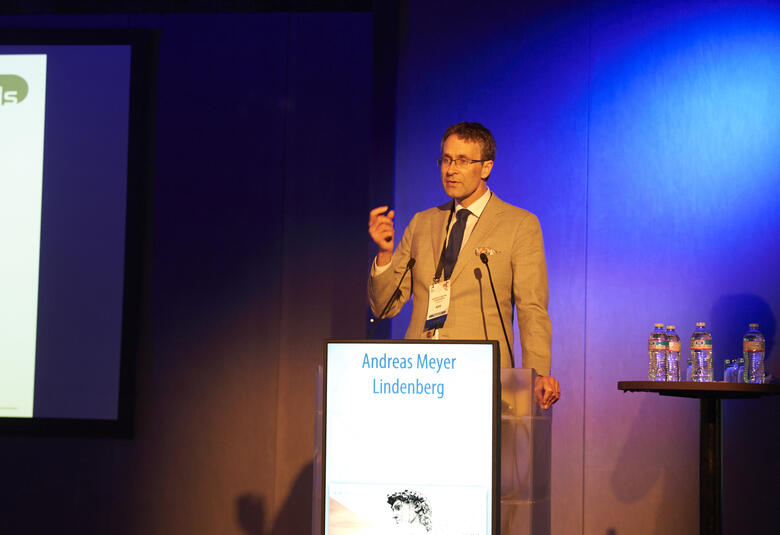
Can psychiatric disorders be predicted and prevented?
This early morning symposium contained two pressentations on the prediction and prevention of mental health disorders. Dr Stefanie Schmidt, from Bern in Switzerland spoke about efforts to predict and possibly prevent psychosis, and Prof Danuta Wasserman from Stockholm, Sweden spoke about the relative impossibility of accurately predicting suicidal behaviour in an individual, and the initiatives now being investigated for intervention in this.
Making your move early
As psychosis commonly has an onset early in life, and often proves to be a life-long condition that severely compromises patients’ levels of functioning, there are clear financial and psycho-social advantages to preventing or mitigating the effects of psychosis in individuals. Dr Schmidt explained that prediction has focussed on the assessment of signs and symptoms that may indicate the early stages of or a predisposition for psychosis. Intervention at this stage aims to reduce the number of patients in whom this sub-clinical syndrome converts to a diagnosis of psychosis.
Spotting the early signs
Two types of tools have been developed to aid prediction: the ultra-high-risk (UHR) and basic-symptom (BS) criteria. The UHR criteria are designed to identify individuals who are at risk of conversion to psychosis within a short period of time. These include the presence of attenuated psychotic symptoms and/or brief limited psychotic symptoms and/or a combination of a biological risk factor (commonly a family history of psychosis) with a recent functional deterioration. BS criteria aim to capture subtle, self-experienced psychopathology beyond positive and negative symptoms, which may foreshadow the development of psychosis.
Dr Schmidt reported a large meta-analysis designed to investigate rates of conversion to psychosis in around 5000 patients who were deemed to be at risk of psychosis by either UHR or BS criteria and followed up for at least 6 months. Pooled conversion rates to psychosis after 12 months were 15% for patients meeting UHR criteria and 25% for those meeting the high-risk criterion of cognitive disturbance. These rates of conversion increased to 29% and 50%, respectively, at 3 years’ follow-up. In this analysis, patients younger than 18 years had lower conversion rates than adults, although there was no difference in the assessment of risk between these two groups.
Treat before it takes hold
A second meta-analysis investigated early intervention in more than 10000 patients at risk of psychosis. Of the 15 studies included, nine were of psychological interventions, primarily cognitive behavioural therapy, and six were of pharmacological intervention, primarily with antipsychotics. These interventions produced a significant risk reduction of conversion to psychosis of 56% at 12 months, with a number needed to treat of 15. At this stage, there appeared to be little difference in efficacy between psychological and pharmacological treatments.
Dr Schmidt therefore recommended a staged-intervention approach, starting with psychological treatment and moving to pharmacotherapy if required.
Results of these two meta-analyses have been incorporated into new evidence-based EPA guidelines on the early detection of clinical high risk for psychosis and on early intervention in clinical-high-risk states of psychosis, both of which are published in European Psychiatry this month.
How can I know what’s on your mind?
Psychosis, along with other psychiatric disorders is a strong risk factor for suicide. Nevertheless, as Prof Wasserman pointed out, the risk of suicide even among patients with psychiatric or personality disorders is not predictable for the individual. This is because suicide risk comprises an unpredictable combination of factors relating to the individual, their past and present circumstances, socio-economic status and their current motivation for suicidal behaviour, which can vary rapidly over time. At a time when suicide is very much on the minds of many people in Europe, this makes the work, not only of clinicians but also of those around people who are contemplating suicide, extremely difficult.
Turning away from that path
Dr Wasserman presented some hope for the future, both for prediction and prevention. Genetic studies have revealed some potential new markers for suicide risk in genes associated with glutamatergic and opioid neurotransmission and the HPA axis. In combination with other risk factors, such markers may allow targeted intervention and suicide prevention for some individuals. Dr Wasserman also discussed a large prevention study conducted in European schools. In one arm of this, children were engaged with awareness-raising activities, designed to inform them about suicide, provide them with some strategies and resilience in dealing with difficult situations, and to produce a barrier to suicidal behaviour. This study produced a large and significant reduction in suicide attempts and serious suicidal ideation in these school children, providing hope that such widespread intervention may have far-reaching effects.
Our correspondent’s highlights from the symposium are meant as a fair representation of the scientific content presented


